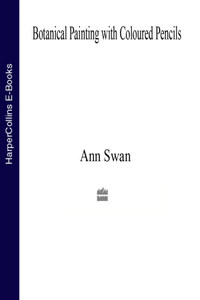∆ PINK CAMELLIAS
50 x 36 cm (20 x 14 in)
COPYRIGHT
First published in 2010 by
Collins, an imprint of
HarperCollins Publishers
1 London Bridge Street
London SE1 9GF
www.harpercollins.co.uk
Collins is a registered trademark of HarperCollins Publishers Limited.
© Ann Swan, 2010
A catalogue record for this book is available from the British Library
Editor: Geraldine Christy
Photographer: Richard Palmer
Jacket painting:
GINGER FLOWERS
54 x 36 cm (21 x 14 in)
Ann Swan asserts the moral right to be identified as the author of this work.
All rights reserved under International and Pan-American Copyright Conventions. By payment of the required fees, you have been granted the nonexclusive, non-transferable right to access and read the text of this e-book on screen. No part of this text may be reproduced, transmitted, downloaded, decompiled, reverse engineered, or stored in or introduced into any information storage retrieval system, in any form or by any means, whether electronic or mechanical, now known or hereinafter invented, without the express written permission of HarperCollins e-books.
Source ISBN 9780007275526
Ebook Edition © SEPTEMBER 2018 ISBN: 9780008328252
Version: 2018-10-02
HarperCollinsPublishers has made every reasonable effort to ensure that any picture content and written content in this ebook has been included or removed in accordance with the contractual and technological constraints in operation at the time of publication.
∆ PURPLE ANEMONES
30 x 44 cm (12 x 17 in)
∆ LINE OF BULBS
30 x 46 cm (12 x 18 in)
Line of Bulbs are reproduced by kind permission of The Southern Bulb Company of Texas, USA.
FOREWORD
THE ART OF drawing and painting plants has a long history: it ranges from decorative framed paintings to very detailed scientific illustrations, often in pen and ink. I have collected botanical illustrations for more years than I care to remember and I love to discover the work of new artists.
Most botanical artists use watercolours. Time was when an illustration in coloured pencils was instantly obvious because of its grainy appearance. But coloured pencils have improved immensely, and there has been a huge increase in the number of artists who use coloured pencils to produce refined work.
Ann Swan has extraordinary skill. Her illustrations range from conventional plant portraits (mainly flowers and fruits) to exquisite portrayals of dying autumnal plants and leaves, and exuberant studies of fruit and vegetables in which the available space on the paper is completely covered. She also likes to combine coloured-pencil work with graphite pencil, or draws in graphite pencil alone.
All Ann’s work shows an infectious enthusiasm for, and understanding of, her chosen subject and demonstrates her meticulous observation and attention to detail. She is an outstanding exponent of coloured-pencil painting. This book will not only be of enormous help and encouragement to anyone who wants to learn how to produce coloured-pencil illustrations: it will be an inspiration.
Victoria Matthews BSc (Hons), Dip.Tax., FLS
Botanist
∆ FLY AGARIC TRIO
Amanita muscaria
25 x 28 cm (10 x 11 in)
INTRODUCTION
In Spring, when Flow’rs your garden grace,
With Needle or Pencil you can trace
Each curious Form, and various Dye
So represent unto the Eye,
Nobly proportion ev’ry part,
That Nature blushes at your Art.
John Rea, Flora, 1665
Coloured pencil is an ideal medium for botanical painting. It is immediate, portable, easily manipulated and very forgiving, making it useful for both the beginner and the more accomplished artist.
This is a very exciting time to be working in coloured pencils. Since I came to the medium in the late 1980s, many new and extended ranges have been introduced that contain better quality and more lightfast pigments. There is also a great variety of blender pencils, blender pens and battery-operated erasers now available. All these new products make it so much easier to produce vibrant and finely detailed plant portraits.
I started using coloured pencils as a way of introducing areas of colour into my detailed graphite pencil drawings. I tried watercolour, but I could not cope with using brushes – they seemed to have a will of their own – and all my colours turned to mud. At first I used colour only for part of the image, but as I have learned more about coloured pencils and the way they perform I have concentrated on enjoying colour.
∆ ‘JANUARY KING’ CABBAGE
30 x 32 cm (12 x 13 in) Coloured pencil and graphite pencil over underpainting.
Through this book I hope to share with you the techniques, tips and ideas that I have tried and tested. With a clear overview of the materials that are currently available and how to use them, the book shows you how best to get to know your subject and explains how to create interesting and eye-catching compositions. It also looks at ways of finely tuning your work and presenting it well, both on the ‘page’ and in the frame. Finally, there is a gallery showing some beautiful work by other artists and students who use this versatile and increasingly popular medium.








